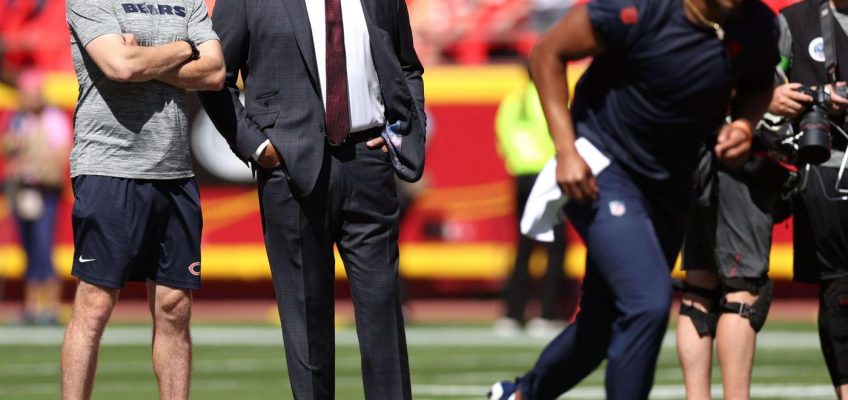Facing third-and-10 at the Ohio State 22-yard line in the second quarter Saturday, Michigan quarterback J.J. McCarthy had wide receiver Cornelius Johnson split wide to the right as his primary read.
Ohio State had a safety over the top of the left side, and McCarthy liked the matchup for Johnson, who was running a go route and hoped to shake Davison Igbinosun with a stutter step, maybe convincing the cornerback he was breaking off his route near the line to gain.
The Wolverines were thinking touchdown — not first down.
Igbinosun didn’t take the bait and Johnson was covered. McCarthy didn’t have a lot of time to react. Buckeyes defensive tackle Mike Hall Jr. collapsed the pocket with a bull rush. From McCarthy’s blind side, defensive end J.T. Tuimoloau beat left tackle LaDarius Henderson with a spin move. The escape hatch was closing.
McCarthy kept his eyes on Johnson, hoping to hold safety Malik Hartford to the right side as wide receiver Roman Wilson crossed from the left with cornerback Denzel Burke in close coverage. Just before Tuimoloau hit him, McCarthy zipped a pass across the middle — his release is compact and fast — somehow threading the ball between Burke and Hartford and into Wilson’s hands.
Wilson caught the ball at the 5-yard line and squirted into the end zone, putting the Wolverines ahead 14-3 in a game they won 30-24 to improve to 12-0 as delirious fans stormed the field at Michigan Stadium afterward.
It was the kind of big-time throw — McCarthy didn’t stride into it with Tuimoloau bearing down on him — that’s a wow moment for NFL evaluators considering McCarthy at or near the top of a talented crop of quarterbacks for the 2024 draft.
That’s if the junior from LaGrange Park decides to enter the draft after Michigan’s season ends. The Wolverines play Iowa in the Big Ten championship game Saturday at Lucas Oil Stadium in Indianapolis (7 p.m., Fox-32). A 22-point favorite, second-ranked Michigan is a shoo-in for its third straight College Football Playoff berth with a victory.
McCarthy has a lot to contemplate, including the future of the Michigan program with the NCAA investigating coach Jim Harbaugh for an alleged scheme to illegally scout future opponents in person. Harbaugh will return Saturday from a three-game Big Ten suspension.
In the time being, McCarthy has meaningful games to prepare for with the Wolverines hunting their first national title since 1997. And for now he can talk about the throw to Wilson, a highlight-reel play for McCarthy, whose passing production was limited in the games Harbaugh was banned from the sidelines.
“I had a good one-on-one on the outside,” McCarthy said, “and he didn’t win. We had a crossing route coming across, so I knew if I kept my eyes on the single receiver (Johnson) that (Hartford) might move over and open up a little space for Roman.”
Rewatch the play a handful of times and you will see Hartford budged only slightly. But McCarthy’s eyes held him long enough to keep that little window cracked open.
“Then I’ve just got to put it in a can of cola, honestly,” McCarthy said.
The touchdown pass to Wilson wasn’t the only big play McCarthy made. Three plays before the score, Michigan put it in his hands on fourth-and-1 from the Buckeyes 29 with a play fake that resulted in a quick throw to tight end Colston Loveland for 7 yards.
McCarthy’s final numbers were not overwhelming — he completed 16 of 20 passes for 148 yards and ran four times for 17 yards — but that has been the case most of the season as the Wolverines are heavily committed to running the ball and haven’t often needed to air it out.
Michigan ranks 122nd out of 133 FBS schools in passing-play percentage (39.5%). That’s one layer to evaluating McCarthy against USC’s Caleb Williams, North Carolina’s Drake Maye and LSU’s Jayden Daniels when considering how the quarterback class will stack up. None has declared for the NFL draft, though Daniels is out of college eligibility. All could be top-10 picks.
The Bears have been doing their homework on college quarterbacks in the event they elect to move on from Justin Fields. Owning the Carolina Panthers’ first-round pick — which, based on current standings, would be No. 1 — as well as their own, currently No. 4, puts general manager Ryan Poles in a position to control the direction of the QB class.
Imagine if a local kid — McCarthy was a five-star recruit at Nazareth before finishing his high school career at IMG Academy in Florida during the COVID-19 pandemic in 2020 — was drafted to be the savior for the local franchise.
It’s possible Bears fans who were glued to Saturday’s game to watch Ohio State wide receiver Marvin Harrison Jr. (118 yards, one touchdown) — and dream about what he could accomplish at Soldier Field — were watching the team’s future quarterback.
Standing out in the class
Assuming Williams, Maye and McCarthy declare for the draft and join Daniels, it will be fascinating to watch the scouting process play out between now and April 25.
Williams entered this season as the presumptive No. 1 pick, and while he still might wind up in that spot, he endured a bumpy season for the 7-5 Trojans, who lost five of their final six games. The defense, offensive line and skill-position players surrounding the 2022 Heisman Trophy winner were badly exposed at times.
“I love McCarthy,” one veteran NFL executive said. “He may not have enough juice to get him over Williams, but there is something about J.J.”
Maye and the Tar Heels (8-4) also hit a late-season swoon, losing four of their final six games, as he played about half the season with an ankle injury. Like Williams, Maye didn’t have the best line in front of him, and he had only one high-level skill player in wide receiver Tez Walker.
Daniels led the No. 1 scoring offense in the FBS (46.4 points per game) while throwing for 3,812 yards with 40 touchdowns and only four interceptions and rushing for another 1,134 yards. Losses to Alabama and Ole Miss kept the Tigers (9-3) from reaching the SEC title game, and they also fell in the season opener to Florida State. Daniels benefited from elite receiving talent.
The first thing that jumps out when lumping the four quarterbacks together is that McCarthy’s statistics, other than his 74.3% completion rate, are outliers. He has attempted only 257 passes while the other three average 257 completions. McCarthy’s 2,483 yards are more than 1,100 fewer than the other three have. He has 19 touchdown passes against four interceptions.
After winning their first nine games by an average of 34 points, Michigan went to State College, Pa., on Nov. 11 for a matchup against then-No. 9 Penn State. NFL folks were curious to see how McCarthy would respond against a better opponent.
The Wolverines got out to a 14-9 halftime lead and ran the ball on their final 32 offensive plays. Amid that onslaught of ground-and-pound, McCarthy had a keeper on a designed rollout for a throw that didn’t materialize, and a pass interference penalty against the Nittany Lions wiped out an attempt. Other than that, it was run after run after run to put away a 24-15 victory.
McCarthy finished 7 of 8 for 60 yards, and the large collection of scouts at the game was left to wait for another week to dig in on him as a passer. It was apparent from the outset the Wolverines were ill-prepared to block Penn State defensive end Chop Robinson, and with the Nittany Lions offense stuck in the mud, Michigan was able to punt and play defense without much threat.
“Would have loved to see him throw more than eight (expletive) times,” one scout who attended the game texted as he left the stadium.
One question worth addressing is why Harbaugh and his coaching staff have not put more on McCarthy’s shoulders if they believe he is an elite quarterback.
“That’s Harbaugh,” one NFL general manager replied. “He’s going to do what he does. I give that kid credit. A lot of kids crumble there.”
When the game at Penn State ended and the Wolverines were two wins from reaching the Big Ten title game, something caught the attention of another evaluator who was present.
“The thing I liked, he knew there were a ton of scouts there and he threw it eight times,” he said. “Yet after the game, J.J. was celebrating. He didn’t give a (hoot). You saw him running all over. Tells me loud and clear he is a team guy.”
Rewind to mid-September and a 31-6 win over Bowling Green. McCarthy was 8 of 13 passing for 143 yards with a career-high three interceptions and said afterward he forced too many throws.
“He’s definitely athletic enough in the pocket,” said a national scout with Michigan in his territory. “He’s got all the necessary arm talent. He’s accurate enough. I like his confidence. There’s that fine line of taking risks and not being stupid, and usually he’s at that line. For whatever reason, there’s been a few games this year he’s been crossing that line.
“He’s a legit first-round contender based on what I’ve seen. I’m optimistic about what he can be. I don’t have a strong conviction at this point.”
Schematic advantage?
McCarthy did put up big numbers last year in the 51-45 CFP semifinal loss to TCU in the Fiesta Bowl. Yes, the Horned Frogs returned two interceptions for touchdowns, but he was under consistent pressure from blitzing linebackers and passed for 343 yards and two touchdowns, nearly leading the Wolverines back from a 15-point halftime deficit.
It was the kind of wide-open game that caught the attention of scouts pointing toward his junior season, and that leads into another Harbaugh-related topic of whether Michigan’s system better equips the quarterback for the NFL based on what he’s asked to do.
“Yes,” said a general manager who has seen McCarthy play this season. “Because he’s running a more pro-style attack. He is in a different offense than all these other guys getting all of the stats.
“Now, he’s in shotgun a lot, too, but he’ll get under center. You can see him work through progressions. He still needs some work at that. He’s accurate but misses throws like they all do. But it’s more of a pro style with what they’re doing with Harbaugh. They run the hell out of it, which helps the quarterback with the play action. He’s an interesting guy.”
That gives McCarthy somewhat of a base, whenever he does enter the league, for understanding how footwork and timing need to match up in an NFL passing offense. The Wolverines identity is to control the line of scrimmage and tempo with their running game, as opposed to some of the offenses producing quarterback talent that are more spread-based, relying on half-field reads.
For an NFL team considering McCarthy, that makes what type of offense the team runs a key factor.
Does it become a difference maker in the evaluation process? Probably not. But it’s part of the calculus, and three years of experience playing for a coach who has won as an NFL head coach and played quarterback in the league creates additional value.
A head for football
The comparison game is always dangerous. You wind up trying to draw parallels between college players and guys who performed similarly and then reached the highest levels of accomplishment in the NFL, which has a way of chewing up and spitting out highly drafted quarterbacks in rapid succession.
“You hate to compare, right?” Harbaugh told Michigan media at the start of the season about McCarthy. “But very much like Andrew Luck. Once in a generation. I knew it first with Luck (whom Harbaugh coached at Stanford). Just the way he took the field for practice as a true freshman. Just the presence they have when they walk on the field and the first time you give them the quarterback position.
“There it is with J.J. First day he walked out on the practice field here at Michigan, that’s what came to mind. It was very Andrew Luck-like, the presence and the demeanor — the everything. Yeah, (it’s) well-documented J.J. McCarthy’s as much of a generation quarterback here at Michigan or anywhere.”
What set apart Luck — a four-time Pro Bowl selection in seven years with the Indianapolis Colts before his abrupt retirement in the 2019 preseason — was elite processing ability and a high football IQ. That’s what scouts are hinting at when raving about McCarthy, who turns 21 next month.
Those pounding the table for McCarthy believe that, from the shoulders up, he’s built to play in the NFL at a high level, even if his 6-foot-3, 202-pound frame is a little on the slender side.
He doesn’t run like Daniels and isn’t as elusive as Williams and might not win a foot race against Maye, but he’s slippery enough in the pocket and can make second-reaction plays. He throws with good velocity and accuracy, and the quick release is a big plus. He can operate from all sorts of platforms.
It remains to be seen how the Bears will order the quarterback prospects when evaluating them and then comparing them with what they have in Fields, who is under contract through 2024 with a fifth-year club option for 2025.
Poles was part of a Kansas City Chiefs organization that zigged for Patrick Mahomes in 2017 when most of the league zagged, ranking Deshaun Watson tops at the position. The Bears, of course, went in another direction altogether by drafting Mitch Trubisky at No. 2 ahead of Mahomes and Watson.
The Chiefs, who had a successful veteran at the time in Alex Smith, were able to see through the inherent challenges an Air Raid system thrower like Mahomes would face and clearly evaluate what he could become under coach Andy Reid.
Does that mean Poles will lead a different wave of thinking at Halas Hall in the offseason? Who knows. But he will be able to draw from that process and the notebooks of questions that were asked and answered along the way to a decision that, in retrospect, was as stunning as it was brilliant.
Listening to McCarthy describe how he processed his choices on the touchdown pass to Wilson against the Buckeyes, it was evident he has been trained to assimilate reads from presnap to the split seconds that follow the snap and then act.
“Unbelievable mind,” one high-level evaluator said. “Can’t make any judgment on him until they play (more) high-level teams.”
A win over the Hawkeyes would thrust Michigan into the CFP again, giving McCarthy one or two of those opportunities. The NFL will be watching.
()




